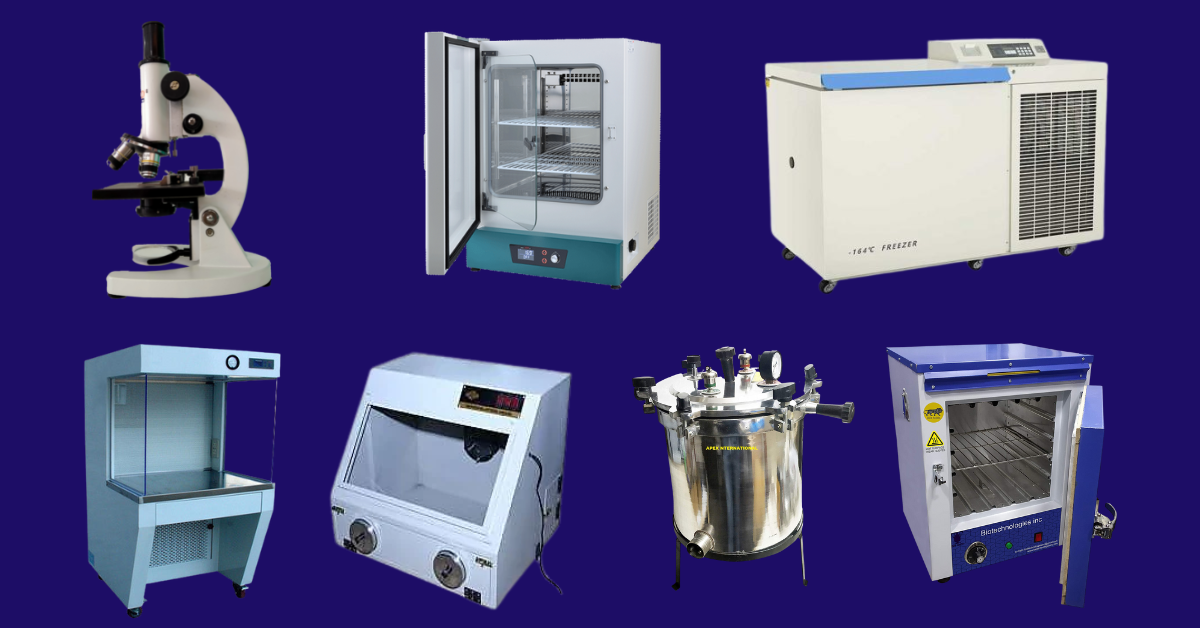1. BOD Incubator: It is often called low temperature incubators are one of the most important lab equipment in many research centers, hospitals and other pharmaceutical labs. BOD incubators is the most versatile and reliable low temperature incubator which is designed to maintain at 20 degree celcius necessary for biological oxygen demand/ biochemical oxygen demand determination. BOD incubators provide controlled temperature conditions accelerated tests and exposures.
Applications
a. It measuring waste loadings to treatment plants and in evaluating the BOD removal efficiency of such treatment systems.
b. It measures the molecular oxygen utilized during a specified incubation period for the biochemical degradation of organic materials and the oxygen used to oxidized in organic materials such as sulfides and ferrous iron.
2. Aseptic Hood: The air in the lab is thick with microorganisms. By handling pure culture during inoculation, airborne microorganisms could contaminate the sterile medium. As a result, an inoculation operation is typically performed in a separate cabinet or hood. Laminar air flow aseptic cabinets are one of two types of equipment used to create an aseptic atmosphere. The inoculation hood is used in biological culture investigations to produce an environment free of bacteria and fungi in the chamber using ultraviolet germicidal light.
3. Laminar Flow Cabinet: A laminar hood, sometimes referred to as laminar air flow, is an enclosed bench made to guard against contamination of particle-sensitive equipment or biological particles. A fan and HEPA filter are part of a laminar flow hood. The fan draws air through a filter pad that traps dust; next, the pre-filtered air must pass a HEPA filter to eliminate contaminants like dust, fungi, and germs. Now that sterile air has entered the workspace, you can complete all of your flasking tasks without worrying about contamination.
4. Autoclave: It is laboratory equipment that uses the steam under pressure approach to sterilise items including rubber tubing, aprons, and culture medium. Also, it is employed in the decontamination process to sterilise contaminated materials like discarded culture medium and contaminated dressings.
Types of autoclave:
a. Stovetop autoclaves: These devices, which are regarded as modified pressure cookers, need an external heat source.
b. Front load autoclaves are more popular than stovetop autoclaves because they are more practical for sterilising. They have a box-like design and are self-contained. They have a heating unit that converts water into steam for sterilisation, and the operator can adjust the temperature using the various controls. Moreover, they have temperature and pressure sensors to record the corresponding data.
5. Hot Air Oven: Syringes, pipettes, Petri dishes, test tubes, liquid paraffin, oils, powders, and flasks are just a few examples of the glassware that can be sterilised with this electrically powered apparatus.
Precautions:
a. When adding the items for sterilisation, the glassware should be dry and clean.
b. Before sterilising, glass items such as pipettes, flasks, and test tubes must be wrapped in paper or aluminium foil.
c. It should not be permitted for the temperature to rise above 180 degrees Celsius.
d. All sterile items must only be removed once they have reached room temperature.
6. Deep Freezer for Lab: In order to preserve and keep medical supplies, blood samples, medications, and injections, among other things, for an extended period of time, deep freezers are the testing equipment used in scientific labs. Deep freezers come in a variety of varieties, including blood bank refrigerators, freezer dryers, and extremely low deep freezers. These gadgets come in a variety of shapes and sizes; sometimes they have standard designs, other times they have tiny designs. Depending on the needs of the test application, different instruments have different specifications and functions.
7. Compound Microscope: The world of microorganisms would not have been explored without the compound microscope, which is a fundamental tool for scientific research and education. An image can be magnified twice with the use of a compound microscope. It makes use of an objective lens with a wide range of powers and an eye piece that aids in enlarging the image created by the objective lens. Several mechanical and optical components make up a typical compound microscope.
A. MECHANICAL PARTS
- Foot or base: It is a horseshoe shaped solid part at the bottom of microscope on which the most of microscope stands
- Pillar: it is the small projection from the foot or base with inclination joint at top
- Inclination joint: it is a hinge joint by which the upper part of microscope can be tilted in upwards and downward direction
- Stage: it is a metallic platform with two clips and a hole in the centre. The clips holds the glass slide and the hole allows the light from the mirror to reflect on the object.
- Arm: it is a curved handle used to carry the microscope. It supports the tube and connects it to the base
- Body tube: it holds the optical parts like eye piece and objectives at proper working distance from each other.
- Nose piece: it is fitted at the base of the body tube and holds different objectives with different magnifying powers (10×, 40× 100×)
- Coarse adjustment knob: it is used to move the body tube up and down to focus the image on the object.
- Fine adjustment: it is used to view finer details of the objects or specimen.
B. OPTICAL PARTS:
- Mirror: it is fixed below the stage and used to regulate the light to illuminate the object through the hole on stage. It has two faces; a plane and a concave. When natural light is available , plane mirror may be used and in artificial light, concave mirror is used.
- Iris/Diaphragm: it is located between the mirror and the object . it has an aperture which can be widened or narrowed as required. Thus it regulates the intensity of light that reaches the specimen
- Condenser: it is fixed between the mirror and stage. It concentrates or focuses the light rays on the objects
- Objectives: low power objectives, high power objectives, oil immersion objectives
- Eye piece : it consist of a lens placed at the upper end of the body tube.






